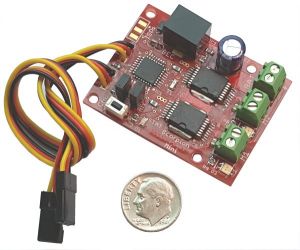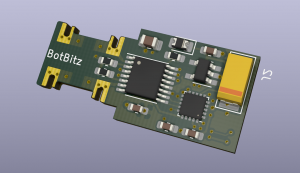ESCs
Electronic Speed Controllers, or ESCs, are circuits that let you control motor speed and direction remotely, using a signal from the radio receiver. One circuit board may have one or more motor controllers, and some small ESCs are integrated with a receiver to minimize size and weight for small bots. They are called "Electronic" speed controllers to distinguish from an obsolete electro-mechanical type which were used in RC models long ago (1980s?).
How ESCs work
An ESC plugs into the receiver. It changes the pulses that would have moved a servo, and makes them into a variable motor voltage instead. ESCs have a connection to draw power from the battery, and another to attach to the motor(s).
Selecting an ESC
Note: Beginners may be quickly overwhelmed at the selection of ESCs available. It is convenient to choose ESCs that are designed for use in combat robotics from the many Suppliers available. A wide range of other ESCs are available for model hobby purposes, but you must select carefully. When in doubt, ask other builders.
Considerations in selecting a suitable ESC include:
Motor type
There are two completely different types.
- Brushed ESCs only drive brushed DC motors.
- Brushless ESCs only drive brushless motors.
- Hybrid controllers, like some from Castle Creations, can be set to either brushed or brushless mode.
Safety
An ESC must stop running the motor if it stops receiving a signal; otherwise, this could result in a runaway bot, or a bot that can't stop its weapon or prevent self-damage. If your bot doesn't "fail safe" with no signal from your transmitter, it will not qualify for competition.
Battery voltage
ESCs are rated for a maximum voltage. Exceeding this voltage may lead to immediate failure of the ESC.
Current rating
ESCs are given a current rating, for example "30A" for a 30 amp ESC. High-quality ESCs will have separate ratings for continuous current flow, and peak or maximum current flow. Cheap ESCs are often advertised by the maximum current rating, which they can output for only a few seconds. You can still use them to save money, but be conservative about their capabilities; a basic "30 amp" ESC might be fine for a motor requiring 5 amps.
Continuous current
An ESC must be able to provide the full speed motor current of the motor it controls for the full length of a match. If it can't, it will stop working or burn out from thermal overload.
Peak current
If a motor is jammed or brought to a stop ("stalled"), it will demand much more current than normal. For some applications this won't happen much, but in combat robots, it happens all the time! If you get into a pushing match, get stuck, or your motor-spun weapon strikes your opponent and comes to a dead stop, peak current will come into play.
Your motor will have a published "stall current" or "locked rotor amperage" indicating the demand that will be placed on your ESC in this situation. Select an ESC that will not be damaged by that current level, at least not immediately. Try to be aware of your motors while driving, and shut off the power if a motor is jammed to preserve the ESC and wiring. Again, be wary of current ratings given for inexpensive hobby ESCs.
Consider using belt slip, a shaft clutch, or other methods to physically avoid stalling the motor. Combat damage may of course increase loading or cause a jam even if the bot was designed to avoid it.
Size / Weight
Physical size and weight is always a consideration when choosing components for combat robots, especially in insect-class robots where every gram counts. If you allow extra mass and volume for your ESC, you can choose one with a larger heat sink which will be less likely to overheat and therefore more tolerant of overload.
Sensor capabilities
Advanced builders may want to use brushless motors with shaft sensors and matching ESCs to better control speed, acceleration, or torque, making the bot easier to operate with precision. These units are more costly and require programming or tuning to achieve the desired performance.
Additional features
- Battery Elimination Circuit (BEC) - this takes the voltage from the battery down to a lower level that is more typically used in receivers and servos which eliminates the need for a second receiver battery. BECs on speed controllers typically don't provide a lot of current, so if you are using a 5 volt servo in your bot you should consider a stand alone BEC.
- Channel Mixing - Lets you operate multiple drive motors with just one control stick, even with the simplest radio transmitters. Applicable only to dual-channel ESCs that can control two motors.
- Reversible - If you are using the ESC to operate any motor that has to spin both ways (drive wheels, for example), the ESC must be "reversible" — that is, capable of bidirectional operation.
- Battery Monitoring and Protection - Shuts off the motor to save the battery from damage due to excessive discharge. Consider if you want your ESC to cut off power to your motor and leave you vulnerable late in a match -- it may be worth risking battery damage to keep fighting!
- Thermal Monitoring and Protection - Shuts off the motor to keep the ESC from being damaged by overheating.
- Tuning Settings - May help you better control the bot or make the most out of your motors. Particularly useful for brushless ESCs.
- The ability to reflash (reprogram) the ESC; see below.
Firmware and Reflashing ESCs
We've reached a time in history (and in hobbies) where it seems like every small device is run most cheaply by a tiny computer chip, including ESCs. They operate according to built-in programming, or firmware. Reflashing the firmware changes the program in the ESC's computer, and therefore how the motor is driven and powered.
This section will be a short introduction only, as the world of ESCs is ever-changing and far larger than just robots. If you're a beginner, buy ESCs from Suppliers that specialize in robot combat parts and use their community, documentation, and tech support to help make the most of this technology.
Firmware
BLHeli is a free and popular replacement firmware package. BLHeli_S is a separately developed alternative (fork).
AM32 (Firmware) is an increasingly common firmware option. This article gives a brief introduction to its rise in popularity.
Warning: Note that as of 2024, BLHeli32 is no longer being supported, and ESCs with BLHeli32 can't be flashed with new BLHeli32 settings. If you own, buy or inherit an ESC with BLHeli32, it will continue to work with the settings previously installed. It can be repurposed for AM32, but it will require some hacking to overwrite the firmware loader in the ESC. Once that is done, it can accept AM32 or other compatible options.
Reflashing Tools
BLHeliSuite is a computer program made to reprogram brushless ESCs and adjust exactly how the motor is controlled. One common reason to do this is to take brushless ESCs made for other purposes, and make them fit for robot combat.
A popular online alternative is ESC Configurator. A Chromium-based browser like Google Chrome or Microsoft Edge is required.
Repurposing ESCs
It may be possible to reflash the firmware on an ESC meant for other uses to make it reversible. Fortunately, nearly all ESCs now fall into common design categories, using well-known chips and circuits which all work pretty much the same electrically. Here are some examples of ESCs that could be repurposed for robot combat.
- ESCs for car and truck applications have reversing ability, unless they have the very simplest of radio controls.
- ESCs made for quadcopters and drones are normally brushless and originally programmed to spin propellers for lift only.
- ESCs designed for airplane flight are also intended to spin a propeller one way only. Note that to save weight, airplane ESCs may also have smaller, lighter heat sinks intended for air cooled operation; these should be avoided or modified.
- ESCs for boat duty may not be able to reverse, and some are designed to be water cooled and have no heat sink at all.

